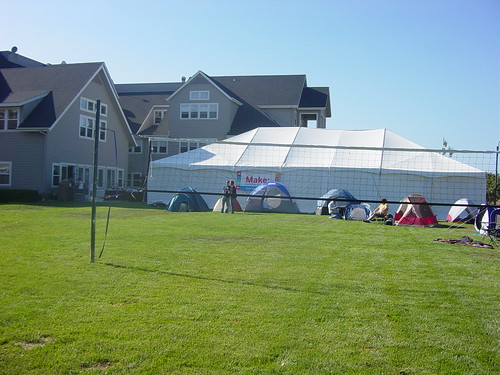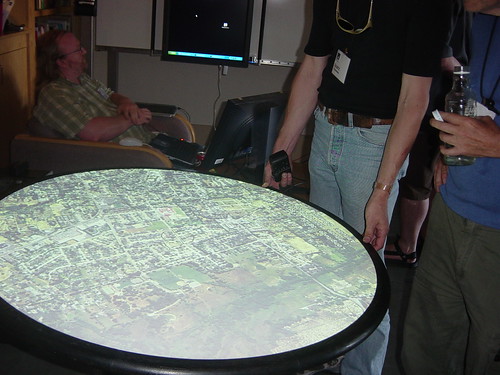Foo Camp 2006
This year, I was one of the lucky few who received an invitation to O’Reilly’s Foo Camp. Like many people, I had heard just how cool this exclusive get-together is, but I was nowhere near prepared for how mind-blowingly awesome the Foo Camp experience can be.
I arrived in Sebastopol on Friday afternoon and began to unpack my tent. The tent I bought ended up being bigger than I expected I think I grabbed the wrong one, but it worked out fine given that I was sharing it with Alex Graveley. Alex wasn’t there yet, though, so I started to unpack it myself, which ended up being a bit difficult… But then a very kind and helpful Mark Shuttleworth walked by and offered a hand. Before long, the tent was set up and I was ready for the fun.
There were only a handful of people there at this point, so I decided to walk around and see the place. One of the rooms had this interesting table with a map on it. A projector was mounted above, and people were around the table, turning and tilting. It was quite cool. Turn the table and it zooms in and out. Tilt it and the map moves. It was the most natural way of viewing maps that I’ve ever used. Quite addicting in a way.
Outside was this kind of round spinnable art thing. It was like the table, but had this colored fluid sand-like substance inside. It was held up at an angle, and when you spun it, the sand-like stuff made some cool patterns. That was also fun to play with. 🙂
Before long, most of the Foo Camp guys were there, and we gathered under a tent to introduce ourselves and learn what was in store for us. It was amazing to see the people who were there. The creators of Digg, del.icio.us, LiveJournal, Second Life, 43things, Amazon, Meebo, Django, Chumby, people from Google, Microsoft, Intel, Yahoo… The list goes on and on.
I went to several sessions. There was one on the future of IM, another on robots, one on Dr. Who vs. Snakes on a Plane, another on Chumby hacking. I think I went to another one or two, but I can’t remember right now. They were all pretty interesting, and there were many more I didn’t have time to go to.
As mentioned above, one of the session talks was about Chumby. Chumby is a cute, soft, squishy Linux computer that is designed to sit next to your couch or your bed or whatever and stream flash content to you. The software and hardware are all open source, and there’s people modifying the casing of the Chumby and sticking it in teddy bears, Teletubbies, Hello Kitties, etc. It’s currently very pre-alpha (both the hardware and the software), but we all knew that. The Foo campers received free Chumbies. The public release will be in like 6 months or so, and should by then have more features and be a bit more stable. Still, it’s an interesting concept, and I hope they come up with a killer app for it. With an intended price tag of $150, it could be a good purchase with the right target audience and apps.
At nights, we would play Werewolf. This is pretty much a Foo Camp tradition, and is played well into the night. I was a werewolf only once, but we kicked ass that one time 🙂
Let’s see, what else was there… A Google plane flew overhead and took pictures, which will go on Google Maps at a 2 inch resolution. There were flame-throwing robots, a clown, lots of good food, new friends, a reverse scavenger hunt… Probably more things than I can list. It is the best event I have ever gone to, and I hope to be invited back next year. To whoever it was that put me on the invite list, thank you. This was an opportunity I will never forget.
(More pictures available in my gallery and tagged on Flickr.)





